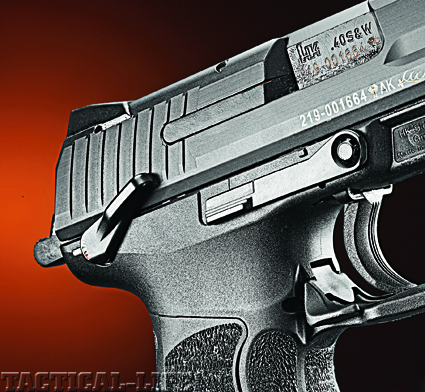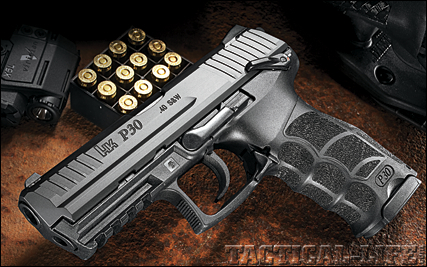The P30S (S stands for manual safety) from HK brings the popular and powerful .40 S&W chambering to this popular pistol, which features fully ambidextrous controls and modular grip panel inserts.
Heckler & Koch’s P30S is a new addition to the P30 series that has been highly successful since being introduced to the US market in 2007. Domestic sales of the P30 and P30L (full-size version) easily outpace the USP and P2000 series. Like most new centerfire autos, this pistol follows a predictable commercial evolution: manufacturers first introduce a 9mm because of that cartridge’s worldwide popularity, then offer a .40 S&W caliber with additional features often dictated by consumer feedback.
The .40 S&W cartridge’s dimensions and chamber pressure allow the P30S to share the 9mm version’s frame size; with differences only in barrel, recoil springs and magazine. The “S” in its model number designates a manual safety. A 9mm pistol from the P30 series is the official duty sidearm for three major European police forces—one of which did not consider the P30’s decocker as a suitable substitute for a manual safety, and this request prompted the P30S.
Advertisement — Continue Reading Below
Gun Details
 HK considerately made all controls of the P30S ambidextrous, from the slide release to the safety to the mag release.
HK considerately made all controls of the P30S ambidextrous, from the slide release to the safety to the mag release.
The P30S is a mid-size German-made pistol that uses the familiar tilting block, locked breech design with a polymer frame and steel slide assembly. The pistol has fully ambidextrous controls: safety, decocker, slide release and magazine release. The slide release levers are longer than on most pistols and clearly designed to be operated by the thumb of the firing hand as a quick method of chambering the first round. The decocker sits unobtrusively below the hammer. HK’s magazine release levers on the rear of the triggerguard are longer and more easily activated than those used on the P2000 and USP.
This pistol is available in five variants that differ with respect to hammer (spur or not) and inclusion of a decocker. To those who use the decocker as a “safety substitute,” a manual safety on a pistol with a decocker is superfluous because the trigger pull weight is now about 11-plus pounds—just as long as double-action revolvers which typically do not have manual safeties. However, the addition of a safety lever to a pistol with a decocker does have two advantages. First, in conjunction with an internal device that locks the firing pin until the trigger is depressed, the manual safety allows the P30S to be safely carried “cocked and locked” or in “Condition 1.” This gives the user the benefits of a consistent and relatively light single-action trigger stroke on both the first and subsequent shots, helping shot placement. The downside on a defensive pistol is the need for a high degree of “trigger finger discipline.” The operator must be extremely judicious in keeping his finger completely off the trigger (in most cases aligned alongside the frame) until ready to fire on an identified target. Studies show that police often engage in “trigger search” during stressful situations, which can lead to more accidental discharges with a light, short trigger stroke than with the hammer decocked and a longer, heavier stroke.
Advertisement — Continue Reading Below
























